In this article, I’ll walk you through how guitar cracks affect the sound of your acoustic or electric instrument. Each crack comes with its own potential set of concerns, but, in my experience, cracks on acoustic guitars are usually more severe than cracked electric instruments.
Hopefully, the crack in your guitar doesn’t look like the guitar neck in the photo above! That’s what happened to the Les Paul copy guitar I was playing back in the late 1970s after it came unhooked from the guitar strap and its neck hit the stage floor. I had a drink in my left hand, so I could not catch it in time!
Needless to say, it was unplayable and needed immediate care! Read on to learn more about what you should do when you discover a crack in your guitar.
You can use the table of contents below to take you to the area that interests you. Click on the little box to open it, and then click on the section of the article you want to read, or you can read from start to finish if you want the whole educational experience!
The Short Answer
A crack can affect the guitar’s resonance, tone, and sustain to various degrees, depending on the type of guitar, where the crack is, and its length and depth. A crack on an acoustic or hollow body guitar is usually more concerning than on a semi-hollow body or solid body guitar.
Keep On Reading (Below) To Learn More
Solid Body Vs. Acoustic Guitar Tone
First, let’s briefly talk about the difference between electric and acoustic guitars since they create their sound in totally different ways, although both types vibrate to create all or part of the tone.
Electric Tone
An electric guitar comes in three varieties, solid body, semi-hollow body, and hollow body. These guitars are designed to carry sound mainly through their magnetic pickups, although the semi-hollow body and especially the hollow body models have an acoustic component, too.
A crack in a solid body guitar is least likely to affect its tone since its body is a solid piece of wood.
Semi-hollow body and hollow body electrics vibrate a lot more, so even a small crack may change the way they resonate when strummed or picked. This, in turn, changes the tone of what you hear, especially if they are not plugged into an amplifier.
Acoustic Tone
An acoustic guitar has a totally hollow body, which vibrates more than an electric guitar. Traditionally, all the music came from the guitar’s soundhole, so vibration and resonance produced the tone.
These days, acoustic guitars can have piezo-electric pickups that give them an optional “electric” (magnetic) component.
A Scratch Is Not A Crack!
There is a big difference between a scratch and a crack in a guitar! Here is what you need to know about each one.
Guitar Scratches
A scratch is usually a cosmetic problem involving the paint or finish of a guitar, sometimes extending into the surface of the wood. I remember the first time I discovered a scratch in the body of my Sears “learner-guitar.” I was devastated and tried unsuccessfully to make it disappear in a number of ways.
Scratches don’t compromise the structural integrity of a guitar and won’t change its sound. However, a deep scratch in the wrong place, like on the back of the neck, can feel annoying as your hand slides over it while you play.
If you play a particular guitar long enough, it will most likely become scratched, especially if you gig with it. This normal wear and tear won’t harm the instrument’s functionality.
Some players pay extra for instruments that have been “factory-reliced'” to make them look old and well-played. It has a cool look and gives your audience the impression that you have been playing for many years.
Here is a Fender Custom Shop 1960 Stratocaster heavy relic model. If you look closely, you can see the checking in the nitro lacquer finish and the white primer under the faded sonic blue finish. Professionally relicing a guitar to make it look realistic is an art that takes years of experience.
Note the mint-green pickguard that mimics the aging process of one that was originally white. Historically, it was actually a defect in the plastic that caused the color change.
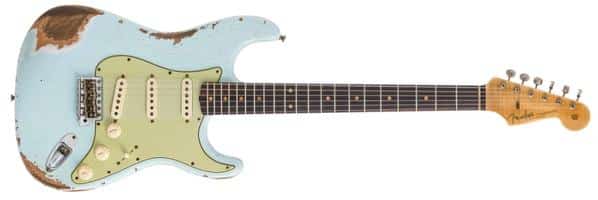
Guitar Cracks
A crack extends below the finished surface of a guitar into the wood and can compromise the instrument’s structural integrity, depending on its location and depth. Cracks on acoustic guitars are usually much more serious than on solid body electrics.
The body of an acoustic guitar is hollow, while an electric instrument may have a solid, semi-hollow, or hollow body. Even a hollow body electric usually had more structural stability than an acoustic guitar, based on the way it’s built.
See Semi Hollow Body Vs Hollow Body Guitars – The Complete Guide for more info.
Cracking is not a normal part of a guitar’s aging process and is always worrisome. The guitar’s wood is never purposefully cracked when it is reliced correctly.
How much a crack can affect the sound of a guitar depends on what type of guitar it is, where the crack is located, and how long and or deep it is.
Here is a photo of an acoustic guitar with a crack in the top surface (soundboard). It appears as if the crack has been repaired. This is a critical area to repair correctly. If the crack extends under the bridge and widens, it can lead to the bridge loosening on that side.
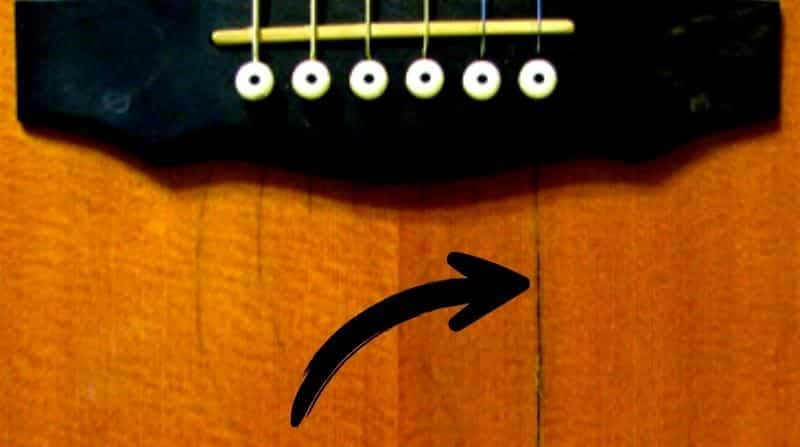
Cracking Can Lead To Bigger Problems
Sometimes cracking that is not repaired can lead to adjacent damage.
Here is an extreme case. Do you recognize the acoustic guitar below? It is Willie Nelson’s iconic guitar, “Trigger.” He has played this guitar so much that he wore out the area near the bridge, plucking the strings. He used this guitar for 47 years at over 10,000 concerts worldwide!
You can actually see the bracing inside the guitar through the hole in the wood.
Most likely, the damage started as a crack or two and then eventually compromised the structural integrity of the wood, leading to the hole formation.
The hole does not extend under the bridge of the guitar. It’s not like Willie couldn’t afford to buy a new one! He became attached to it and claimed that the hole is part of what gives his guitar its signature sound. Luckily, Trigger is under the watchful eye of guitar repair and restoration expert Mark Erlewine.

Why Crack Location Matters
The crack’s location can significantly affect the severity of the problem and the sound of the instrument. Cracking on an acoustic guitar usually causes more problems than on an electric one.
Electric Guitars

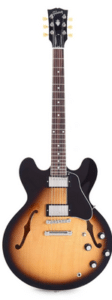
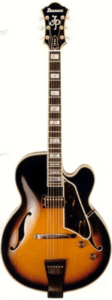
Body
Electric guitars’ front, back, and sides, especially solid bodies, are usually more difficult to crack than an all-acoustic instrument.
Since a solid body is just one big “plank” of wood, it usually takes a pretty significant crack to change the resonance and tone. Semi-hollow bodies are pretty durable, but hollow bodies can crack pretty easily, especially if dropped.
Severe cracks in solid bodies can be problematic.
Jeff Beck accidentally broke the body of his surf green prototype signature guitar into two pieces after a stage mishap (he threw it up in the air but didn’t catch it in time). He tried repairing the body and putting the same electronics, hardware, and neck on a different body, but it didn’t sound the same.
Neck
The neck of an electric guitar can be easier to crack than an acoustic instrument, due to the instrument’s extra weight, especially after a fall due to a guitar strap failure.
Les Paul guitars are notorious for severe neck injuries after trauma, like the ones in the photo at the beginning of this article. The tilt-back headstock, lack of reinforcement at the volute (where the neck and headstock meet), and the thin wood between the nut slot and truss rod channel make them very susceptible to breaks.
The Gibson SG guitar has the same neck problem, which is one of the reasons Les Paul asked to have his name removed from the Les Paul SG guitar, which became called the SG model.
Acoustic Guitars
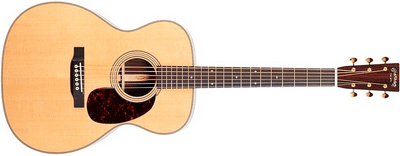
Cracks on acoustic guitars are seen more frequently than on electrics due to their delicate nature. They are typically seen from dropping the guitar or dehumidified wood that is too dry.
They can occur in every area of the guitar.
Front (Soundboard)
Cracks very commonly occur on the guitar’s front (top) due to the thin and delicate nature of the wood here. The top is made thinner than the sides and back so that the strings can make it resonate more. A decrease in resonance diminishes the guitar’s volume level and affects the tone in a negative way
If the bridge pulls away from the guitar, it can cause the top to crack in one or more areas.
NEVER put steel strings on a nylon (classical) guitar! The increased tension will cause the bridge to loosen and cracking of the surrounding wood! I’ve seen this happen a couple of times. If you want a steel-string acoustic, go out and buy one!
Back
Although the back of the guitar is thicker than the front, it can still be damaged, especially if the guitar is dropped. These cracks usually have less of an effect on the instrument’s resonance and tone than the front.
Cracks in the back are more frequently ignored since they are not visible to the audience.
Sides
Cracks in the sides of a guitar typically happen when the instrument falls after the back end of the guitar strap becomes unhooked. Although the sides resonate less than the front and back, a crack can affect the guitar’s tone if it is severe.
Neck
The neck is commonly cracked after being dropped, especially after the guitar strap closest to the neck slips off the strap button or the guitar is leaned against an amplifier or chair.
Over-tightening or over-loosing the neck’s truss rod can cause a crack in the guitar neck. If you don’t have the proper tools or experience to adjust the truss rod, bring the instrument to a certified guitar tech to avoid permanently damaging the neck!
The guitar neck vibrates at the nut and transmits sound into the body via the neck joint. A cracked neck can cause a significant loss of tone!
Never Ignore A Crack!
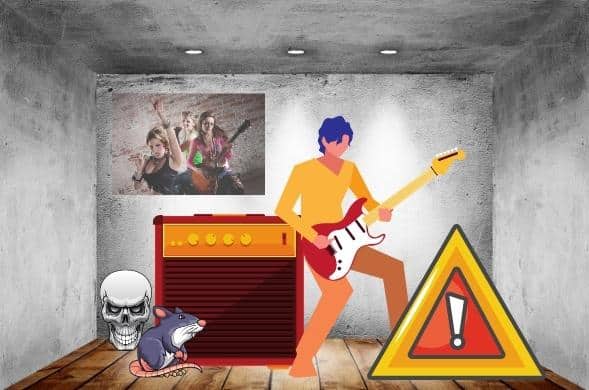
All cracks on any guitar should be appropriately fixed to return the instrument to its original state. Even a “hairline” crack can create a serious problem!
Ignoring a crack can cause the following problems:
- Crack may worsen, and further damage the guitar
- Can decrease the volume of acoustic, semi-hollow body, and hollow body guitars
- Decreases the resonance of the wood at the body and neck
- The overall tone and sustain of the guitar may suffer
- Lowers the resale value of the instrument
Evaluating The Severity Of The Crack
It’s a good idea to check your guitars for cracks whenever you change strings, clean them, or hear an abnormal sound while playing. Start from the top of the headstock and methodically work your way down the neck and body, looking at the front, back, and sides, all the way to the bottom.
Some cracks may be hidden under a guitar’s pickguard or bridge. Look inside a guitar’s soundhole or f-holes for partial thickness cracking that may not be visible from the outside.
Generally speaking, cracks on the body and neck of a guitar that are greater than ½ inch (1.3 centimeters) long are concerning and should be dealt with immediately, especially on acoustic instruments.
It’s usually difficult to judge the actual depth of a crack, but cracks on the body of an acoustic guitar are typically full-thickness.
A crack can quickly worsen in length and depth, especially in an area directly impacted by string tension. So, if you have an acoustic guitar or an electric one with a glued-on wooden bridge, the string tension can destabilize it if the crack extends to it or under it.
Preventing Additional Damage

If you notice a crack in your guitar, it’s essential to take steps immediately to help prevent additional damage to the instrument.
- Stop playing the guitar
- Loosen the tension on all strings
- Avoid extremities of temperature and humidity
- Keep the crack free of debris
- Get the guitar evaluated and repaired as soon as possible
Repairing The Crack
All cracks are not dealt with the same way. The type of guitar, tonewood, finish, and the crack’s location, length, and depth must all be carefully considered to repair the instrument properly.
The crack may need to be prepared first by removing any dirt, debris, and finish material using the right chemicals to avoid further damage to the area and to achieve an excellent cosmetic result.
The correct adhesive must be used to make the repair structurally sound. With acoustic guitars, the crack may need to be glued from the outside and also repaired from the inside with a cleat (a small piece of wood that is glued over the crack).
The repaired crack may also need to be covered with a suitable finish material blended into the surrounding area to make it invisible or difficult to spot.
Some cracks on acoustic guitars with very dehydrated wood may virtually “disappear” when properly humidified to around 40 to 50 percent. The guitar should still be evaluated by a repair professional.
Are You Qualified To Make Guitar Adjustments Or Modifications?
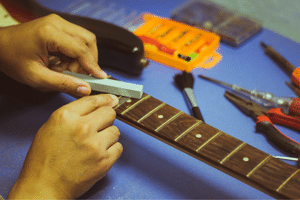
It’s great to work on your guitars, especially if you have a lot of them, but you should always be aware of your limitations.
You should not try repairing the crack unless you have the proper training and experience, especially on an expensive instrument. You could make the situation worse and lower the guitar’s retail value even more! Take the guitar to a certified technician or luthier.
Adjusting things like an electric guitar’s string height (action) or pickup height can be straightforward. Still, some adjustments require the proper training and experience, like adjusting a guitar’s truss rod.
Making modifications to your guitar can void its manufacturer’s warranty and cause permanent damage to the instrument. Certain modifications are irreversible, so you may be stuck with them, even if you desperately want to restore the guitar to its original condition!
I learned that the hard way over the years until I did a three-year apprenticeship in a guitar repair shop. Now I have my own home workshop with the proper training and equipment to safely maintain and repair all my instruments.
Remember: “When In Doubt, Send It Out!”
Frequently Asked Questions

Here are some of the questions I get asked about guitar cracks.
If your question does not appear here, please put it in the comments, and I will get right back to you with an answer.
How Do You Tell If Your Guitar Is Cracked?
Carefully examine the instrument. Even hairline cracks are usually visible upon close inspection. Listen for “rattling or buzzing” sounds when the guitar is strummed or picked. For more specific info, see the section above.
Can A Crack In A Guitar Be Fixed?
Yes, most cracks can be fixed or stabilized, so they do not continue to expand and cause irreversible damage to the instrument. It’s always best to properly repair the crack as quickly as possible.
Should I Buy A Cracked Guitar?
Generally speaking, I would be cautious about buying a cracked guitar, especially if it is an acoustic instrument and the crack is adjacent to or extends under the bridge. Bargain for the lowest price and factor in what it will cost you to get the guitar properly repaired.
If you’re buying the guitar from a store that has a repair shop, ask them to fix it as part of the sales deal.
Does A Hole In A Guitar Affect The Sound?
Apart from a central soundhole or f-holes, holes caused by cracking or trauma to the instrument can affect the sound to some degree, usually for the worse. An abnormal hole in a guitar can also destabilize the wood and cause permanent damage to the instrument.
At What Humidity Do Guitars Crack?
A guitar is more likely to crack from dehydration at around 30% to 35% humidity or lower, especially if it is an acoustic instrument. Ideally, a guitar’s humidity should be about 40% to 50%.
Make sure you control the humidity of your guitar’s environment. If your skin is dry and your guitar lives in the same room, it probably has the same problem! If you keep an acoustic guitar in a case, consider using a humidifier. It’s essential to store your guitar at the proper humidity to avoid damaging it.
What Temperature Is Best For Guitars?
The ideal guitar temperature is between 66 to 77 degrees Fahrenheit (19 to 25 degrees Celsius). It’s ok to temporarily expose your guitar to temperatures lower or higher during transport, but always let it equilibrate to room temperature before you attempt to play or tune it. It’s important to store your guitar at the right temperature to avoid damaging it.
Final Thoughts

Now you know how guitar cracks affect the sound of your instrument, and I hope it helped you decide what to do about them!
To review, here are some of the most important points.
A scratch in a guitar’s finish is not the same as a crack.
Acoustic guitars are generally more susceptible to severe damage from cracks than solid body electrics.
The location of the crack matters. Cracks near or under the bridge of an acoustic guitar are cause for concern, and neck cracks can be a serious issue in both types of instruments!
Never ignore a crack, no matter how small. Even “hairline” cracks can damage your instrument! Take the steps listed above to prevent additional damage and have it evaluated and repaired as soon as possible!
Don’t try to repair the crack yourself if you don’t have the proper tools or experience! I can’t tell you how many guitars I’ve seen where the owner has done even more damage trying to repair it improperly.
Here is a fabulous video from StewMc by guitar repair expert Dan Erlewine. He shows you how to repair a crack in the top of a boutique acoustic guitar by gluing it on the outside and installing a cleat on the inside. Check it out!
Also, see Why Is My Guitar Tone So Bad? -Massively Improve Your Sound! for more info.
Tell Me What You Think

Please leave a comment below if you enjoyed this article, have any questions about guitar cracks, or want to give your point of view. I will be happy to help you.
- Are you likely to take cracks more seriously after reading this article?
- Do you have a crack in your guitar? What are your plans to repair it?
- What’s the worse crack you’ve ever had in a guitar, and how did you address it?
- What else is on your mind?

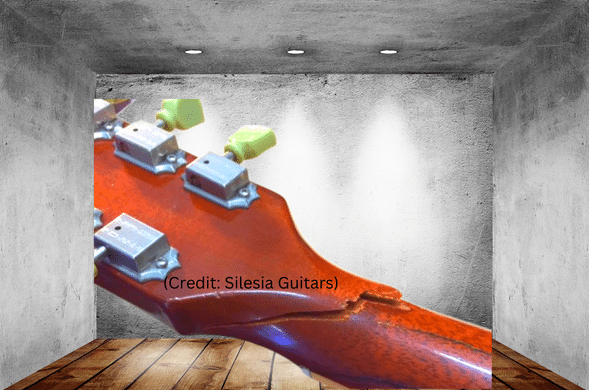

A very in-depth guide to guitar cracks! I can imagine that something that is designed to vibrate beautiful tones can be ruined if it has a crack in it.
My grandad loved playing his guitar, and many other instruments. He was self taught and was able to get a lovely sound out of any instrument put in his hand!
My brother now plays guitar, I think it important to have s place to come to learn about the options out there and how to look after your instrument!
Hi, Tigan
Thank You for your comments!
Yes, it is essential to promptly evaluate and repair cracks in a guitar or any other instrument!
You have a lot of musical people in your family. Perhaps you should consider playing the guitar or another instrument of your choice!
Best,
Frank 🎸
The Yamaha acoustic I currently have is the third guitar I bought since I learned how to use it. I am very careful with how I handle and store it because I really value it.
My first-ever guitar lasted for almost 10 years. Unfortunately, I did not store it at the optimum temperature when I was assigned to another city. I could not bring it with me so just left it in our storage room where humidity can sometimes increase to 85%. When I got back after 3 years, I noticed that it had a crack in its lower body area.
I tried to fix it by putting masking tape over it but the sound was never the same. Nobody wants to use a guitar that sounds weird. ☺
Thanks to this article, I now know better how to take care of my guitar.
Hi, Alice
Thank You for your comments!
If you still have that acoustic guitar with the crack, a certified guitar tech or Luthier can properly fix it. The high humidity may have also done other things to the instrument that need to be addressed or adjusted.
However, it may never sound exactly the same to you again, no matter what you do.
Unfortunately, acoustic guitars are more susceptible to cracking than electrics.
I hope you are enjoying your newest guitar!
Keep On Playing!
Frank
Excellent article. Regarding cracks on the soundboard, I have found that after proper repair the tone is just as good as without the cracks. My 1963 Guild D-50 had at least a dozen cracks during its 60 years. Some cracks were really long and wide. I know it’s not my bias because my friends are astonished at the tone.
Hi, Matthew
I’m thrilled that you found my article helpful!
Wow, a ’63 Guild D-50 is a great guitar!
The tone must be amazing!
Rock On! ?
Frank ?